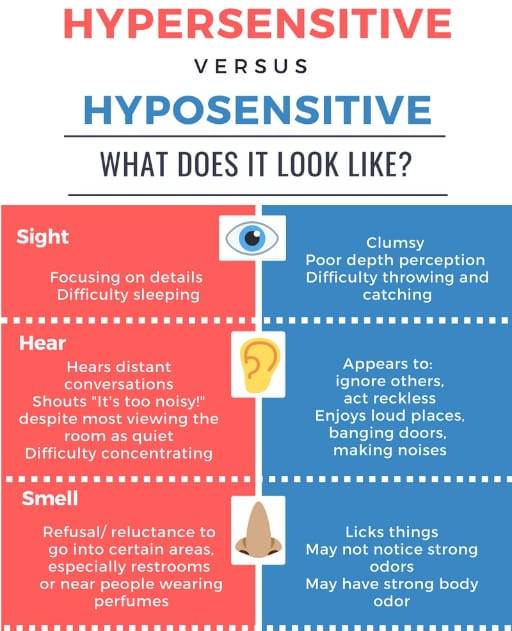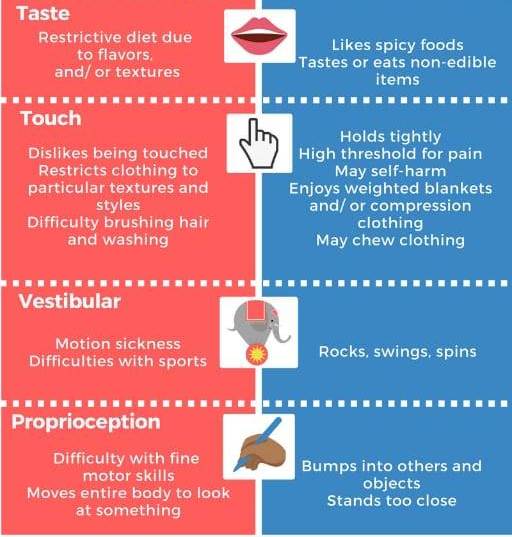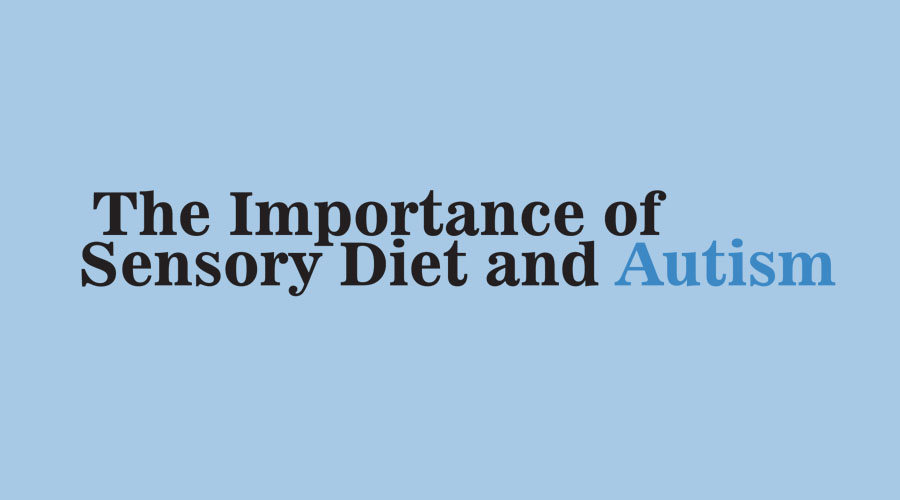The importance of sensory diet and autism
By: Dr Sofia Azad
AUTISM
Autism spectrum disorder impacts the nervous system and affects overall cognitive, emotional, social and physical health of affected individual.The range and severity of symptoms can vary widely common symptoms include difficulty with communication, difficulty with social interaction, obsessive interest and repetitive behavior. For most children, sensory system develops as the child matures, but for others, sensory system does not develop as efficiently as it should. Following are the sensory systems:
Tactile (Touch)
Auditory (Hearing)
Visual (Sight)
Olfactory (Smell)
Gustatory (Taste)
2 Hidden Senses
Vestibular (Movement and Gravity)
Proprioceptive (“Heavy Work”, Input To Muscles and Joints)
- Some children with autism appear to sense the world in a different way as compared to other people. This may manifest as hypersensitivity or hyposensitivity which leads to challenges in learning, development, or behavior.

Therapy based approaches to ASD provide us specific therapy that target the difficulties, include speech therapy, Sensory Integration Therapy and Sensory Diet
What is a sensory diet?
- A “sensory diet” is a treatment strategy used to manage sensory processing dysfunction (also known as sensory motor integration dysfunction).
- In essence, it is a list of sensory activities that helps to keep a child feeling ‘calm’ and sensorial organized that then allows them to attend, learn and behave to the best of their ability.
- More specifically, it is an individually tailored home and/or school, preschool or child care program of sensory and physical (‘motor’ or muscle) based activities.
- It is used to help manage a child’s sensory-motor needs and reduce the impact any such dysfunction may be having upon the child’s attention and activity levels, behavior and/or learning and skill development.
- A sensory diet is used both as a treatment strategy when attention or behavior is problematic as well as a preventative tool in advance of known behavior challenges (exposure to known triggers, certain times of day or specific environments).
Why is a sensory diet important?
- Just like we try to eat a balanced food diet (of more fruit and vegetables and less chocolate) to keep fit and healthy, we also need a balanced amount of sensory information in our bodies each day to allow them to work well.
- A “sensory diet” provides regular opportunities for a child to ‘keep in check’ the imbalance in the sensory stimulation they are lacking, seeking or avoiding, to ensure that the amount received meet the body’s required levels to function well.
- A specifically tailored sensory diet is established then modified over time to meet the individual child’s needs as their sensory processing changes or the environmental demands shift.
- Thus a “sensory diet” consists of sensory activities that help children to feel calm and organized, which then helps them to obtain an optimal state for learning, attention and behaving appropriately.
- As a child learns to self-regulate sensorial (their energy level, behavior, emotion and attention) through the use of a sensory diet, skills such as concentrating, sharing and taking turns also become more mature more quickly. This enables a child to move from depending on others to beginning to manage tasks or situations bythemselves.

What are the building blocks necessary to have success with a sensory diet?
- Sensory processing (emerging): accurate processing of sensory stimulation in the environment as well as in one’s own body.
- Planning and sequencing: The sequential multi-step task/activity performance to achieve a well-defined result such as following a sensory based obstacle course.
- Attention and Concentration (emerging): sustained effort, doing activities without distraction and being able to holding that effort long enough to get the task done.
- Receptive (understanding) Language: Comprehension of spoken language.
- Executive Functioning: Higher order reasoning and thinking skills to create a sensory obstacle course or change the sensory game from on format to another.
- Compliance: The ability of the child to follow through with commands and requests.
How can you tell if a child would benefit from a sensory diet?
If child has sensory processing dysfunction which requires management by a sensory diet this might be demonstrated by the child:
- Being very physically active (to the point they cannot settle to a task) or
- Looking tired and lethargic, or vague and day-dreamy
- Becoming ‘wound up’ with physical activity
- Being unable to settle after being in busy environments
- Having difficulty controlling impulses
- Has trouble modulating the tone of voice used
- Being restless at group time or in crowds
- Being too rough in play
- Failing to understand personal space (invading others inappropriately)
- Having difficulty sleeping
What other problems can occur when a child has sensory processing difficulties that require management with a sensory diet?
When a child has sensory processing dysfunction that requires management with a sensory diet, they might also have difficulties with:
- Following instructions.
- Understanding instructions.
- Working memory (retaining learnt skills).
- Getting to sleep and staying asleep.
- Taking risks in play (either excessive risk taking or being overly cautious).
- Accessing the preschool or school curriculum (due to inattention, poor behavior).
- Academic performance (be this fine motor, literacy and numeracy, peer interaction, organization).
How can a sensory diet be modified to be most effective?
- Frequency of input: The frequency of need varies for each child, and will be guided by observations of the child both before and after the activities. It is often a case of ‘the more often, the better’ to ensure that once a child obtains a “just right” state of organization and attention, sensory diet activities help to maintain this state longer over the course of the day.
- Intensity and duration of input: The effectiveness of the sensory diet will be influenced by not only the frequency of the activities but also the intensity and duration of the activities as well as the ‘goodness of fit’ of the activities to the child’s actual sensory needs.
- Timing of activities: The sensory strategies are best used before, as well as during, activities that are known to be challenging for the child. For activities, such as sitting and listening in class, attending assemblies or playing in a settled manner, the child’s nervous system needs to be calm. To achieve this state before the task, it is helpful to use the strategies in preparation for the activity, particularly in the 10 minutes leading up to the task.
- Incorporate play and daily tasks: For sensory diet recommendations to be effective, it is important to incorporate them into play and daily life, preferably making them part of every day. It often helps to encourage the child to choose activities they enjoy from the list of known effective strategies. Where possible, keep the items used in these strategies, or pictures of these items, in a clear box and refer to it as the child’s “tool box”.
- Record behavior changes: Effective use of the sensory diet is a trial and error process. Thus, wherever possible record the behavior changes noted following engagement in a sensory activity and the intensity, frequency, and duration with which it was provided.
- Alert program is the use of sensory motor strategies in combination with a child’s greater cognitive awareness of their state of sensory organization to achieve self regulation.
- M.O.R.E program uses motor (muscle) components, oral organization, respiratory demands, and eye contact to assist with sensory regulation.
- The Wilbarger Protocol (Deep Pressure Proprioceptive Technique), more commonly known as the ‘Brushing’ program, is a therapeutic program designed to reduce sensory or tactile defensiveness or discomfort and to assist with sensory regulation.
What activities can be used in a sensory diet?
- A sensory diet consists of a range of activities that target the different sensory systems and must be specifically tailored to the child’s needs.
- In order to work out what kind of sensory input is required, the Occupational Therapist and parent collaborate to determine the types of sensory input the child requires based upon formal assessment as well as observations of the child’s responses to a variety of environments and trialed sensory activities.
- The sensory diet activities that may best suit one child, may not necessarily work for another which is why a sensory diet must be developed in conjunction with parents and therapists.
- Different times of the day and different environments may be more conducive to one type of sensory diet activity more than another and it is often a matter of trial and error to determine what will work best for the child (and their careers).
- Not all strategies work all the time. The efficiency depends upon the child’s sensory processing on the day or at that moment, the environment and the demands on the child.
- You may find that strategies that worked really well yesterday do not work today. You may also find that the specific strategies used in the moment are not a good fit that day, but another from the list will be. The activities used in a sensory diet need to be fluid and changeable but providing a consistent kind of input in a different form.
Commonly used sensory diet activities can include:
- Physical activities are the easiest to start with as most children tolerate movement better than any other type of sensory input. Physical activities which use the large core muscles result in a greater amount of sensory stimulation and might include:
- Wheelbarrow walking
- Animal walks (e.g. bear walks, crab walking, frog jumps)
- Trampoline activity
- Cycling or using a scooter
- Swings (forward and back, side to side, rotary)
- Rough and tumble play
- Deep pressure squishing or sandwiching with pillows or balls
- Wearing a heavy backpack for movement (e.g. to carry heavy drink bottle when scooting)
- Playing with weighted items (wheat bag on lap while sitting or heavy blanket for sleep)
- Tactile: Play with play-doh, gloop/slime, kinetic sand, shaving cream, bird seed, rice or any other tactile products. You can just play, draw or hide objects to retrieve in these tactile products.
- Visual: Using torches to look at books, using dot-to-dots or mazes to narrow visual attention.
- Oral: Chew toys or specifically chewy foods.
- Auditory: ‘white noise’ or favored music on an iPod, nose reduction headphones.
- Visual cues can often be very useful to help your child to follow longer instructions as it provides them with something to refer back to if they are having difficulty remembering what they need to do. It also highlights the order in which they need to complete the instruction.
Why should I seek therapy to develop a sensory diet for my child?
- Therapeutic intervention to help a child with sensory processing difficulties that would benefit from a sensory diet is important to:
- Prevent adults encouraging the child to engage in unhelpful activities or unhelpful amounts of sensory input, resulting in typical behavior strategies not working as well as they should.
- Ensure attention, behavior and learning benefits are seen across all environments.
- Help the child self regulate in order to be able to perform in academic and social environments.
- A sensory diet is a tailored program to address the sensory needs of children that helps them to attend, learn and behave better. These are the skills that form the foundation of preschool and school readiness.
- The sensory system continues to develop up until the approximate age of 7. It is for this reason that it is most beneficial to access therapy early. This is not to say that therapy is pointless after this age, but it just becomes more important to know the specifics of what the child’s sensory system requires.
If left untreated what can, difficulties with an inadequate sensory diet lead to?
When child has an inadequate sensory diet they might also have difficulties with:
- Learning and demonstrating this learning in an academic environment.
- Poor self regulation of physical activity, attention, emotion, or thought.
- Ongoing sleep difficulties that can impact on their ability to learn in general.
- Difficulties coping in busy social settings, thus affecting social interactions.
- Anxiety and poor self-esteem issues.
- Social isolation because they find it hard to cope in group situations.
What does the worry look like?
As a parent or carer, are standing by,watching their child feel:
- Angry because so many basic things feel like a challenge?
- Confused by the world around them that doesn’t make any sense?
- Overwhelmed by the demands of simple tasks or safe environments?
- Socially isolated because their classmates can’t relate to them?
Do you as their parent ever feel?
- Ashamed by your child’s behavior (e.g. when they misread this situation)?
- Embarrassed when they overreact to a situation or fail to react appropriately?
- Sadness when they are not invited to parties of their classmates?
- Envy of other parents who don’t deal with the same challenges?
While we can’t change these feelings, we do understand them and we can help to overcome the challenges that are causing the problems.
What type of therapy is recommended to develop a sensory diet?
If your child has difficulties with or needs a sensory diet, it is recommended they consult an Occupational Therapist.
How Can We Help?
An Occupational therapist can help by taking you and your child on a guided journey (as a team) towards their wonderful by:
- Sharing the worry
- Identifying the source of the worry
- Creating a treatment plan (a road map) to minimize the worry
- Working alongside parents and teachers to carry out the treatment plan
- Constantly adjusting the treatment plan to help your child get to their wonderful
What are the benefits of taking this guided (team) journey to wonderful with a therapist?
Well targeted and efficiently delivered therapy can help children to:
- Remove the frustration from daily life and common situations.
- Develop skills, where there was previously just deficit and difficulty.
- Increase Self Esteem and confidence making life feel easier (even if some of the challenges still persist).
- Socially engage with their peers and siblings.
- Learn new skills (be that academic, physical, play, self-care or social).

